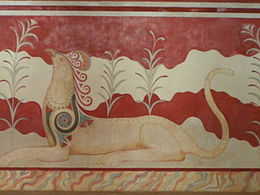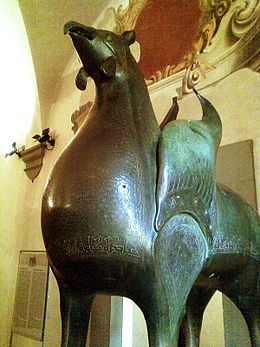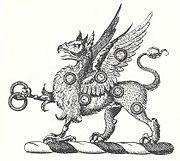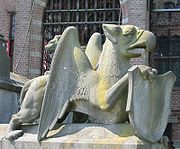- Griffin
-
For other uses, see Griffin (disambiguation).
 Achaemenid griffin at Persepolis.
Achaemenid griffin at Persepolis.
The griffin, griffon, or gryphon (Greek: γρύφων, grýphōn, or γρύπων, grýpōn, early form γρύψ, grýps; Latin: gryphus) is a legendary creature with the body of a lion and the head and wings of an eagle. As the lion was traditionally considered the king of the beasts and the eagle was the king of the birds, the griffin was thought to be an especially powerful and majestic creature. The griffin was also thought of as king of the creatures. Griffins are known for guarding treasure and priceless possessions.[1] Adrienne Mayor, a classical folklorist, proposes that the griffin was an ancient misconception derived from the fossilized remains of the Protoceratops found in gold mines in the Altai mountains of Scythia, in present day southeastern Kazakhstan.[2] In antiquity it was a symbol of divine power and a guardian of the divine.[3] Some have suggested that the word griffin is cognate with Cherub.[4]
Contents
Form
While Griffins are most common in Ancient Greece, there is evidence of Griffins in Ancient Egyptian art as far back as 3,300 BC.[5] [6] Most statues have bird-like talons, although in some older illustrations griffins have a lion's forelimbs; they generally have a lion's hindquarters. Its eagle's head is conventionally given prominent ears; these are sometimes described as the lion's ears, but are often elongated (more like a horse's), and are sometimes feathered. The earliest depiction of griffins are the 15th century BC frescoes in the Throne Room of the Bronze Age Palace of Knossos, as restored by Sir Arthur Evans. It continued being a favored decorative theme in Archaic and Classical Greek art. In Central Asia the griffin appears about a thousand years after Bronze Age Crete, in the 5th-4th centuries BC, probably originating from the Achaemenid Persian Empire. The Achaemenids considered the griffin "a protector from evil, witchcraft and secret slander".[7] The modern generalist calls it the lion-griffin, as for example, Robin Lane Fox, in Alexander the Great, 1973:31 and notes p. 506, who remarks a lion-griffin attacking a stag in a pebble mosaic Dartmouth College expedition at Pella, perhaps as an emblem of the kingdom of Macedon or a personal one of Alexander's successor Antipater.
The Pisa Griffin is a large bronze sculpture which has been in Pisa in Italy since the Middle Ages, though it is of Islamic origin. It is the largest bronze medieval Islamic sculpture known, at over three feet tall (42.5 inches, or 1.08 m.), and was probably created in the 11th century in Al-Andaluz (Islamic Spain).[8] From about 1100 it was placed on a column on the roof of Pisa Cathedral until replaced by a replica in 1832; the original is now in the Museo dell' Opera del Duomo (Cathedral Museum), Pisa.
Infrequently, a griffin is portrayed without wings, or a wingless eagle-headed lion is identified as a griffin; in 15th-century and later heraldry such a beast may be called an alce or a keythong. In heraldry, a griffin always has forelegs like an eagle's; the beast with forelimbs like a lion's forelegs was distinguished by perhaps only one English herald of later heraldry as the opinicus.
Medieval lores
Griffins not only mated for life, but also, if either partner died, then the other would continue throughout the rest of its life alone, never to search for a new mate. The griffin was thus made an emblem of the Church's views on remarriage. A Hippogriff is a legendary creature, supposedly the offspring of a griffin and a mare. Being a union of a terrestrial beast and an aerial bird, it was seen in Christendom to be a symbol of Jesus, who was both human and divine. As such it can be found sculpted on some churches.[1]
According to Stephen Friar's New Dictionary of Heraldry, a griffin's claw was believed to have medicinal properties and one of its feathers could restore sight to the blind.[1] Goblets fashioned from griffin claws (actually antelope horns) and griffin eggs (actually ostrich eggs) were highly prized in medieval European courts.[9]
When it emerged as a major seafaring power in the Middle Ages and Renaissance, griffins commenced to be depicted as part of the Republic of Genoa's coat of arms, rearing at the sides of the shield bearing the Cross of St. George.
By the 12th century the appearance of the griffin was substantially fixed: "All its bodily members are like a lion's, but its wings and mask are like an eagle's."[10] It is not yet clear if its forelimbs are those of an eagle or of a lion. Although the description implies the latter, the accompanying illustration is ambiguous. It was left to the heralds to clarify that.
Heraldic significance
In heraldry, the griffin's amalgamation of lion and eagle gains in courage and boldness, and it is always drawn to powerful fierce monsters. It is used to denote strength and military courage and leadership. Griffins are portrayed with rear body of a lion, an eagle's head, with erect ears, and feathered breast, with forelegs of an eagle, including claws. The combination indicates a combination of intelligence and strength.[11]
In British heraldry, a male griffin is shown without wings, its body covered in tufts of formidable spikes, with a short tusk emerging from the forehead, as for a unicorn.[12] The female griffin with wings is more commonly used.
In architecture
In architectural decoration the griffin is usually represented as a four-footed beast with wings and the head of an eagle with horns, or with the head and beak of an eagle.[citation needed]
The statues that mark the entrance to the City of London are sometimes mistaken for griffins, but are in fact (Tudor) dragons, the supporters of the city's arms.[13] They are most easily distinguished from griffins by their membranous, rather than feathered, wings.
In literature
- For fictional characters named Griffin, see Griffin (surname)
Flavius Philostratus mentioned them in The Life of Apollonius of Tyana:
“ As to the gold which the griffins dig up, there are rocks which are spotted with drops of gold as with sparks, which this creature can quarry because of the strength of its beak. “For these animals do exist in India” he said, “and are held in veneration as being sacred to the Sun ; and the Indian artists, when they represent the Sun, yoke four of them abreast to draw the images ; and in size and strength they resemble lions, but having this advantage over them that they have wings, they will attack them, and they get the better of elephants and of dragons. But they have no great power of flying, not more than have birds of short flight; for they are not winged as is proper with birds, but the palms of their feet are webbed with red membranes, such that they are able to revolve them, and make a flight and fight in the air; and the tiger alone is beyond their powers of attack, because in swiftness it rivals the winds.[14] ” “ And the griffins of the Indians and the ants of the Ethiopians, though they are dissimilar in form, yet, from what we hear, play similar parts; for in each country they are, according to the tales of poets, the guardians of gold, and devoted to the gold reefs of the two countries.[15] ” :)
Griffins are used widely in Persian poetry; Rumi is one such poet who writes in reference to griffins.[16]In Dante Alighieri's Divine Comedy, Beatrice meets Dante in Earthly Paradise after his journey through Hell and Purgatory with Virgil have concluded. Beatrice takes off into the Heavens to begin Dante's journey through paradise on a flying Griffin that moves as fast as lightning. Sir John Mandeville wrote about them in his 14th century book of travels:
“ In that country be many griffins, more plenty than in any other country. Some men say that they have the body upward as an eagle and beneath as a lion; and truly they say sooth, that they be of that shape. But one griffin hath the body more great and is more strong than eight lions, of such lions as be on this half, and more great and stronger than an hundred eagles such as we have amongst us. For one griffin there will bear, flying to his nest, a great horse, if he may find him at the point, or two oxen yoked together as they go at the plough. For he hath his talons so long and so large and great upon his feet, as though they were horns of great oxen or of bugles or of kine, so that men make cups of them to drink of. And of their ribs and of the pens of their wings, men make bows, full strong, to shoot with arrows and quarrels.[17] ”  Griffin misericord, Ripon Cathedral, alleged inspiration for The Gryphon in Lewis Carroll’s Alice's Adventures in Wonderland.
Griffin misericord, Ripon Cathedral, alleged inspiration for The Gryphon in Lewis Carroll’s Alice's Adventures in Wonderland.
John Milton, in Paradise Lost II, refers to the legend of the griffin in describing Satan:
“ As when a Gryfon through the Wilderness
With winged course ore Hill or moarie Dale,
Pursues the ARIMASPIAN, who by stelth
Had from his wakeful custody purloind
The guarded Gold [...]” Modern uses
 The red Griffin rampant was the coat of arms of the Pomeranian ducal House of Griffin and survives today as the armorial of West Pomeranian Voivodeship in Poland
The red Griffin rampant was the coat of arms of the Pomeranian ducal House of Griffin and survives today as the armorial of West Pomeranian Voivodeship in Poland
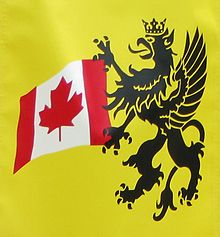 Kashubian Griffin in Canada
Kashubian Griffin in Canada A modernist, Egyptianized guardian griffin by Edmond Amateis (1936), Washington, D.C.
A modernist, Egyptianized guardian griffin by Edmond Amateis (1936), Washington, D.C.
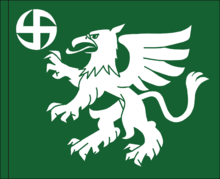 Flag of the Utti Jaeger Regiment of the Finnish Army
Flag of the Utti Jaeger Regiment of the Finnish Army
The griffin is the symbol of the Philadelphia Museum of Art; bronze castings of them perch on each corner of the museum's roof, protecting its collection.[18][19] Similarly, prior to the mid-1990s a griffin formed part of the logo of Midland Bank (now HSBC).
The griffin is the logo of United Paper Mills, Vauxhall Motors, and of Scania and its former group partners SAAB-Aircraft and Saab Automobile. The latest fighter produced by the SAAB-Aircraft company bears the name of "Gripen" (Griffin), but as a result of public competition. General Atomics has used the term "Griffin Eye" for its intelligence surveillance platform based on a Hawker Beechcraft King Air 35ER civilian aircraft [20]
School emblems and mascots
See: List of griffins as mascots and in heraldry
Three gryphons form the crest of Trinity College, Oxford (founded 1555), originating from the family crest of founder Sir Thomas Pope. The college's debating society is known as The Gryphon, and the notes of its master emeritus show it to be one of the oldest debating institutions in the country, significantly older than the more famous Oxford Union Society.[21]
The official mascot of Reed College in Portland, Oregon is the griffin [22].
In 1933, Canisius College in Buffalo, New York selected the griffin as the mascot for its athletic teams and newspaper, in part in reference to the Jesuit-educated La Salle's ship which had sailed nearby 244 years earlier.
The official seal of Purdue University was adopted during the University's centennial in 1969. The seal, approved by the Board of Trustees, was designed by Prof. Al Gowan, formerly at Purdue. It replaced an unofficial one that had been in use for 73 years.[23]
The College of William and Mary in Virginia changed its mascot to the griffin in April 2010.[24][25] The griffin was chosen because it is the combination of the British lion and the American eagle.
In professional sports
The Grand Rapids Griffins professional hockey team of the American Hockey League.
Amusement Parks
Busch Gardens Europe's highlight attraction is a dive coaster called "Griffon", which opened in 2007.
In natural history
Some large species of Old World vultures are called griffins, including the Griffon Vulture (Gyps fulvus). The scientific name for the Andean Condor is Vultur gryphus, Latin for "griffin-vulture". One scientific theory, postulated primarily by Adrienne Mayor, is that the griffin's origins are actually based in ancient paleontologic observations. In the Gobi desert, examples of Protoceratops with accompanying nests and eggs have been identified, yielding an image of a winged, bird-like dinosaurian, that, plausibly, viewed by ancient observers (specimens have been exposed on the surface with no excavations needed) may have been interpreted as evidence of a half-bird-half-beast.
See also
Notes and references
- ^ a b c Friar, Stephen (1987). A New Dictionary of Heraldry. London: Alphabooks/A & C Black. p. 173. ISBN 0906670446.
- ^ Adrienne Mayor, Archeology Magazine, November–December 1994, pp 53-59; Mayor, The First Fossil Hunters, 2000.
- ^ von Volborth, Carl-Alexander (1981). Heraldry: Customs, Rules and Styles. Poole: New Orchard Editions. pp. 44–45. ISBN 185079037X.
- ^ William H. C. Propp,Exodus 19-40, volume 2A of The Anchor Bible, New York: Doubleday, 2006, ISBN 0-385-24693-5, Notes to Exodus 15:18, page 386, referencing: Julius Wellhausen, Prolegomena to the History of Israel, Edinburgh: Black, 1885, page 304. Also see: Robert S. P. Beekes, Etymological Dictionary of Greek, volume 1, Leiden and Boston: Brill, 2010 ISBN 978-90-04-17420-7, page 289, entry for γρυπος, "From the archaeological perspective, origin in Asia Minor (and the Near East: Elam) is very probable."
- ^ http://buffaloah.com/a/archsty/egypt/illus/illus.html#Griffin
- ^ http://www.touregypt.net/featurestories/beasts.htm
- ^ Neva, Elena. "Central Asian Jewelry and their Symbols in Ancient Time" Kunstpedia; citing Pugachenkova, G. (1959) "Grifon v drevnem iskusstve central’noi Azii." Sovetskya Arheologia, 2 pp.70, 83
- ^ Quantara; Hoffman, 318
- ^ Bedingfeld, Henry; Gwynn-Jones, Peter (1993). Heraldry. Wigston: Magna Books. pp. 80–81. ISBN 1854224336.
- ^ White, T. H. (1992 (1954)). The Book of Beasts: Being a Translation From a Latin Bestiary of the Twelfth Century. Stroud: Alan Sutton. pp. 22–24. ISBN 075090206X.
- ^ Stefan Oliver, Introduction to Heraldry. David & Charles, 2002. P. 44.
- ^ Male griffin depicted in Debrett's Peerage, 1968, p.222, sinister supporter of Earl of Carrick (Ireland)
- ^ The City Arms, City of London Corporation, hosted by webarchive
- ^ Flavius Philostratus, The Life of Apollonius of Tyana, translated by F. C. Conybeare, volume I, book III.XLVIII., 1921, p. 333.
- ^ Flavius Philostratus, The Life of Apollonius of Tyana, translated by F. C. Conybeare, volume II, book VI.I., 1921, p. 5.
- ^ The Essential Rumi, translated from Persian by Coleman Barks, p 257
- ^ The Travels of Sir John Mandeville, Chapter XXIX, Macmillan and Co. edition, 1900.
- ^ Philadelphia Museum of Art - Giving : Giving to the Museum : Specialty License Plates
- ^ Glassteelandstone.com, Philadelphia Museum of Art: Benjamin Franklin Parkway, Philadelphia, Pennsylvania, United States, Glass Steel and Stone
- ^ GA-ASI.com
- ^ Trinity.ox.ac.uk
- ^ [1]
- ^ Purdue.edu
- ^ Deadspin.com
- ^ W&M welcomes newest member of the Tribe April 8, 2010
Further reading
- Bisi, Anna Maria, Il grifone: Storia di un motivo iconografico nell'antico Oriente mediterraneo (Rome: Università) 1965.
- This article incorporates text from the public domain 1907 edition of The Nuttall Encyclopædia.
External links
- The Gryphon Pages, a repository of griffin lore and information
- The Medieval Bestiary: Griffin
Heraldic creatures Beasts 
Birds Legendary
creaturesFish Others Categories:- Egyptian legendary creatures
- European legendary creatures
- Greek legendary creatures
- Griffins
- Heraldic beasts
- Mythological birds of prey
- Mythological felines
- Mythological hybrids
Wikimedia Foundation. 2010.

